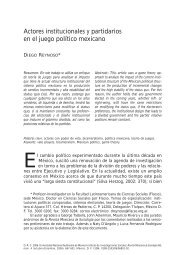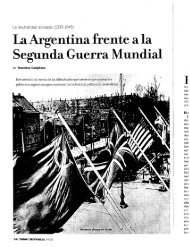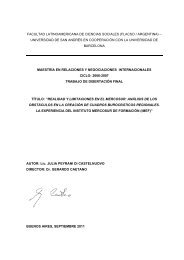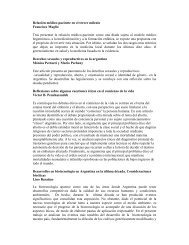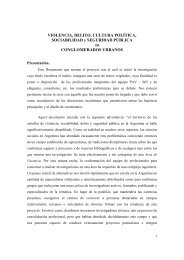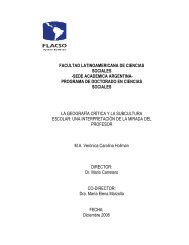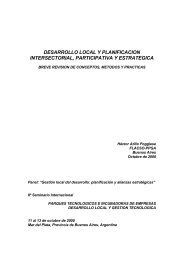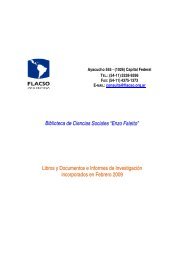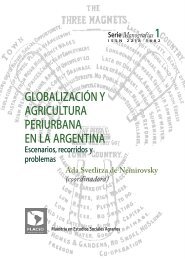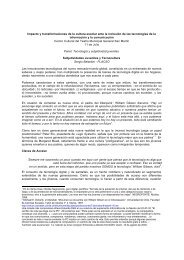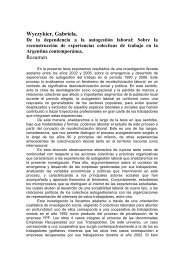Mercedes Botto Andrea Carla Bianculli - Flacso
Mercedes Botto Andrea Carla Bianculli - Flacso
Mercedes Botto Andrea Carla Bianculli - Flacso
You also want an ePaper? Increase the reach of your titles
YUMPU automatically turns print PDFs into web optimized ePapers that Google loves.
nature; in this case, research is used to face complex policy issues in a context of high uncertainty.<br />
Finally, research as argumentation, is used by either policy-makers and/or interest groups may draw<br />
on this research to assume an advocacy position. Once again we are dealing with ideal types [Tussie,<br />
2006], but in order to apprehend the concrete academic-policy relationship, it is worth<br />
decomposing these three categories and see how research has contributed to these episodes of<br />
policy change.<br />
Assuming that research is only one of the many competing sources of information policy-makers<br />
can make use of, and one of the various factors that affect the final policy decision [Tussie, 2006;<br />
Garrett and Islam, 1998], our paper argues that the availability of research and ideas does not<br />
directly translate into policy change. In other words, the research-policy link is not a direct one, and<br />
ideas only influence policy decisions under certain circumstances. Under what circumstances does<br />
availability of knowledge lead to policy change? Following this line of argumentation, we define<br />
policy influence as the result of a process along which three conditions must be present. To the<br />
availability of research or the “production of knowledge”, we must add two other conditions: its<br />
articulation with the stakeholders and mainly with decision makers, and finally, its edition and the<br />
political will of decision makers to make use of it. In other words, in order to capture under what<br />
circumstances research influences the trade policy-making process, understanding how the<br />
production of research and the policy process interact in a particular context turns out to be of<br />
salience.<br />
Building on the current debate regarding the nexus between research and policy-making, and the<br />
factors that contribute to this relationship, we will analyze two key moments within the Mercado<br />
Común del Sur (Mercosur) and the integration process initially launched by Argentina and Brazil:<br />
the CGP, signed within the PICE in 1987, and the CET established in 1994.<br />
2. SETTING THE CONTEXT<br />
After decades of protectionism and of import-substitution policies, most Latin American countries<br />
(LACs) began to open up to the rest of the world in the late 1980s. Different factors converge to<br />
explain this situation: the debt crisis of 1982, dissatisfaction with the results of import-substitution<br />
strategies, and the acknowledgement that the effects on resource allocation of trade policies<br />
characterized by high and dispersed import tariffs, widespread use of quantitative restrictions and<br />
other non-tariff barriers and granting multiple exemptions to import restrictions were no longer<br />
clear. By 1987-1988, it was patent that a fundamental change was needed and that the long-standing<br />
protectionist trade policy could no longer be sustained. A process of trade reform and of reduction<br />
of the levels of protection would then be launched across the region, and gain an accelerating pace.<br />
The end of the 1980s and the beginning of the 1990s marked a turning point in the nature of trade<br />
policies for all LACs3. 3 Except for Chile, the only country which had launched a continuous process of trade liberalization since<br />
1973, when the military coup led by Augusto Pinochet took over.<br />
8



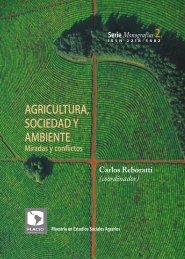
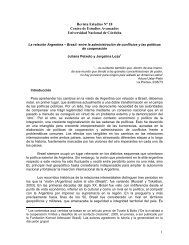
![[P] Disertacion.Melisa.Galvano.pdf - Flacso](https://img.yumpu.com/14596629/1/184x260/p-disertacionmelisagalvanopdf-flacso.jpg?quality=85)
